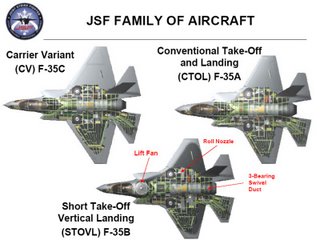HAFB likely to get new jet fighters
Mark "Mustang" Towner, The Spyglass says: Ok Rob B, Orrin H, Chris C and Bob B, I want a check ride the first day they land at HFB OK?
says: Ok Rob B, Orrin H, Chris C and Bob B, I want a check ride the first day they land at HFB OK?
F-35A squadron would ensure future of the base
By Suzanne Struglinski and Joseph M. DoughertyDeseret Morning News
WASHINGTON — A squadron of the Air Force's most cutting-edge fighters could arrive at Hill Air Force Base in 2009, securing the base's future and potentially boosting the state's economy, the Air Force said Wednesday.
The Air Force plans to begin an environmental analysis with the aim of using Hill to house operational squadrons for the F-35A Lightning II, a stealth fighter intended to be the replacement for F-16 and A-10 fighters, which will eventually be phased out. >No A-10 squadrons are based at Hill, although the base does maintenance work on the planes for other bases. But Hill is home to three squadrons of F-16s, or about 70 of those planes. The study could take up to two years, and the first plane could be delivered by 2009, the Air Force said. As many as 24 of the F-35A aircraft, also known as Joint Strike Fighters, could come to the Utah base. Just last week, the defense spending bill passed by Congress included $5.5 million for a public-private partnership by Utah-based Alliant Techsystems Inc. and Hill's Ogden Air Logistics Center to improve production of composite-technology parts needed for the F-35A. Rep. Rob Bishop's senior policy adviser on defense, Steve Petersen, said the environmental study is just a formality, meaning the planes are more than likely to come to Utah. "We don't foresee any show-stoppers there," Petersen said. He said the Air Force's announcement was as big for Utah as when Hill learned it would get F-16s in 1979. The new jets will bring personnel and resources to the base, and will almost certainly protect the base from future closure considerations, he said. "It cements the role of Hill Air Force Base and the Ogden Air Logistics Center in the future as the premier fighter depot," Petersen said. Bishop, R-Utah, represents the 1st District, which includes Hill Air Force Base. He said he always believed the base was a "natural location" for the new jets but "never wanted to take it for granted."
"As the Air Force aircraft inventory ages and budget pressures increase, obtaining the latest and most technologically capable weapons system at our base is crucial," Bishop said. Rick Mayfield, executive director of the Utah Defense Alliance, agreed that the F-35As will help shore up the future of Hill Air Force Base. The alliance, which has been in existence since 1993 to fight periodic rounds of base realignments and closures, most recently lobbied to keep Hill off the Department of Defense's chopping block in 2005. If Hill had closed in 2005, it would have devastated the economy in northern Utah. As the largest employer in Davis County, Hill employs about 23,000 people and pumps $2 billion into Utah's economy, Mayfield said. Retired Army Col. Gary Harter, director of the defense and homeland-security division in the Utah Governor's Office of Economic Development, said the Defense Department now spends less than 1 percent of its budget — about $3.5 billion — on its installations, contractors and services in Utah. He hopes Utah businesses can compete for more contracts and bring more military jobs to the state to the point that the Defense Department is spending $7 billion by 2011. The F-35A is "a nice shot in the arm for us, no doubt about it," Harter said. Petersen said last year's approval of Bishop's bill to create the Cedar Mountain Wilderness Area that protects the Utah Test and Training Range — where Hill's pilots train — was a "key component" of the Air Force's decision to put the jets at Hill. Bishop's bill, supported by the entire congressional delegation, blocked a rail line that would have brought nuclear waste to a proposed storage site in Tooele County and preserved the training-range land from development. Petersen said the time frame for the F-35As' arrival at Hill depends on the plane's production schedule and decisions on funding from Congress. For 2007, the president requested enough money for five planes, but the final defense spending bill approved last week included enough for only two, according to the office of Sen. Orrin Hatch, R-Utah. The final bill included $4.3 billion for continued research into the F-35A, and the conference committee noted that it wanted more testing on the jets before the government buys them on a large scale. The planes cost about $50 million apiece, and they represent "brand new, state-of-the-art technology," Hatch said. "It's going to keep Hill strong for decades." Bishop and Hatch lobbied the Air Force hard for the planes to come to Hill, spelling out that there would be no better place to put them. "Ever since we heard this was coming up, we made the case it should be at Hill," Hatch said. The Air Force intends to purchase more than 1,700 of the F-35As over a 16-year period, beginning in 2009. Kadena Air Base, in Japan, and Shaw Air Force Base and McEntire Air National Guard Station, in South Carolina, will also be studied as bases for the fighters, according to the Air Force. "The capabilities we provide the joint warfighter are in high demand, yet we have the oldest aircraft inventory in our history," said Gen. T. Michael Moseley, Air Force chief of staff. "The Air Force will continue to invest in advanced capabilities needed to defeat the emerging technological advances of our adversaries." Lt. Beth Woodward, spokeswoman for the 388th Fighter Wing at Hill Air Force Base, said teams plan to analyze the various bases for suitability and hear community concerns over the next few months. More information on the F-35A can be found at www.jsf.mil/.
E-mail: suzanne@desnews.com; jdougherty@desnews.com
By Suzanne Struglinski and Joseph M. DoughertyDeseret Morning News
WASHINGTON — A squadron of the Air Force's most cutting-edge fighters could arrive at Hill Air Force Base in 2009, securing the base's future and potentially boosting the state's economy, the Air Force said Wednesday.
The Air Force plans to begin an environmental analysis with the aim of using Hill to house operational squadrons for the F-35A Lightning II, a stealth fighter intended to be the replacement for F-16 and A-10 fighters, which will eventually be phased out. >No A-10 squadrons are based at Hill, although the base does maintenance work on the planes for other bases. But Hill is home to three squadrons of F-16s, or about 70 of those planes. The study could take up to two years, and the first plane could be delivered by 2009, the Air Force said. As many as 24 of the F-35A aircraft, also known as Joint Strike Fighters, could come to the Utah base. Just last week, the defense spending bill passed by Congress included $5.5 million for a public-private partnership by Utah-based Alliant Techsystems Inc. and Hill's Ogden Air Logistics Center to improve production of composite-technology parts needed for the F-35A. Rep. Rob Bishop's senior policy adviser on defense, Steve Petersen, said the environmental study is just a formality, meaning the planes are more than likely to come to Utah. "We don't foresee any show-stoppers there," Petersen said. He said the Air Force's announcement was as big for Utah as when Hill learned it would get F-16s in 1979. The new jets will bring personnel and resources to the base, and will almost certainly protect the base from future closure considerations, he said. "It cements the role of Hill Air Force Base and the Ogden Air Logistics Center in the future as the premier fighter depot," Petersen said. Bishop, R-Utah, represents the 1st District, which includes Hill Air Force Base. He said he always believed the base was a "natural location" for the new jets but "never wanted to take it for granted."
"As the Air Force aircraft inventory ages and budget pressures increase, obtaining the latest and most technologically capable weapons system at our base is crucial," Bishop said. Rick Mayfield, executive director of the Utah Defense Alliance, agreed that the F-35As will help shore up the future of Hill Air Force Base. The alliance, which has been in existence since 1993 to fight periodic rounds of base realignments and closures, most recently lobbied to keep Hill off the Department of Defense's chopping block in 2005. If Hill had closed in 2005, it would have devastated the economy in northern Utah. As the largest employer in Davis County, Hill employs about 23,000 people and pumps $2 billion into Utah's economy, Mayfield said. Retired Army Col. Gary Harter, director of the defense and homeland-security division in the Utah Governor's Office of Economic Development, said the Defense Department now spends less than 1 percent of its budget — about $3.5 billion — on its installations, contractors and services in Utah. He hopes Utah businesses can compete for more contracts and bring more military jobs to the state to the point that the Defense Department is spending $7 billion by 2011. The F-35A is "a nice shot in the arm for us, no doubt about it," Harter said. Petersen said last year's approval of Bishop's bill to create the Cedar Mountain Wilderness Area that protects the Utah Test and Training Range — where Hill's pilots train — was a "key component" of the Air Force's decision to put the jets at Hill. Bishop's bill, supported by the entire congressional delegation, blocked a rail line that would have brought nuclear waste to a proposed storage site in Tooele County and preserved the training-range land from development. Petersen said the time frame for the F-35As' arrival at Hill depends on the plane's production schedule and decisions on funding from Congress. For 2007, the president requested enough money for five planes, but the final defense spending bill approved last week included enough for only two, according to the office of Sen. Orrin Hatch, R-Utah. The final bill included $4.3 billion for continued research into the F-35A, and the conference committee noted that it wanted more testing on the jets before the government buys them on a large scale. The planes cost about $50 million apiece, and they represent "brand new, state-of-the-art technology," Hatch said. "It's going to keep Hill strong for decades." Bishop and Hatch lobbied the Air Force hard for the planes to come to Hill, spelling out that there would be no better place to put them. "Ever since we heard this was coming up, we made the case it should be at Hill," Hatch said. The Air Force intends to purchase more than 1,700 of the F-35As over a 16-year period, beginning in 2009. Kadena Air Base, in Japan, and Shaw Air Force Base and McEntire Air National Guard Station, in South Carolina, will also be studied as bases for the fighters, according to the Air Force. "The capabilities we provide the joint warfighter are in high demand, yet we have the oldest aircraft inventory in our history," said Gen. T. Michael Moseley, Air Force chief of staff. "The Air Force will continue to invest in advanced capabilities needed to defeat the emerging technological advances of our adversaries." Lt. Beth Woodward, spokeswoman for the 388th Fighter Wing at Hill Air Force Base, said teams plan to analyze the various bases for suitability and hear community concerns over the next few months. More information on the F-35A can be found at www.jsf.mil/.
E-mail: suzanne@desnews.com; jdougherty@desnews.com





No comments:
Post a Comment